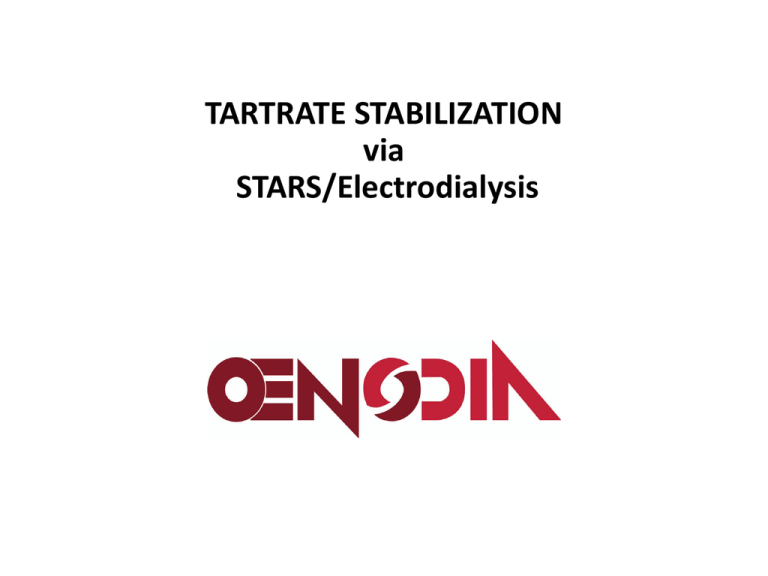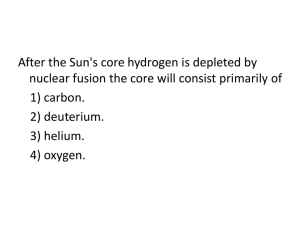STARS/Electrodialysis - Napa Valley Wine Technical Group
advertisement

TARTRATE STABILIZATION via STARS/Electrodialysis What is STARS/Electrodialysis STARS/Electrodialysis • STABILAB predictive & verification test (DIT/ISTC50 • STARS/Electrodialysis 3,200 gal/hr • RO 70%+ waste water reduction clockwise from top left STARS/ED - Annual Volumes Tartrate Stabilized • Machines currently in service: ED800 (ED = Electrodialysis / 800 = gallons per hour) Terravan, CA Chandon, CA St Supery, CA Winesecrets, CA Canadian Winesecrets, CAN Oregon Winery Cht St Michelle, WA Vincor Ontario, CAN Diamond Estate, Ontario, CAN Oenodia, CA ED400 ED1600 ED800 ED800 ED600 ED800 ED1600 ED800 ED800 ED800 (Rental unit) • Average yearly volume processed with above machines: ~ 5,000,000 gal • Average yearly volume for Mobile Service units (Winesecrets) : ~1,000,000 gal • Additional units for 2012: 3 wineries (2- ED800 & 1 ED2400) with annual volume of ~ 3,500,000 gallons • Total approximate annual volume tartrate stabilized: ~ 8MM to 10MM gallons • Annual Global Production: ~ 200 MM gallons or ~ 3% of global wine volume – ~ 10% sparkling – ~ 40% red – ~ 35% white – ~ 15% rose STARS/Electrodialysis Economics If you own a STARS unit: • Operations cost $ 0.03-0.05 per gallon includes membrane replacement • Process from 800 up to 3,200 gallons per hour • Investment $ 200,000 to $ 800,000 Cold stabilization by refrigeration costs $ 0.07-0.16 per gallon. 2 to 3 year Return On Investment, at today’s energy rates. Utility rebates are improving this further STARS/Electrodialysis - How does it work? Continuous operation, controlled by reduction of conductivity from tartrate removal. No additives are used to inhibit precipitation or stabilize the wine. System consists of 4 steps/processes: • Determine reduction of conductivity to achieve stability via STABILAB • Pass wine between the membranes to reduce conductivity by removing tartrates via STARS. • Monitor conductivity to ensure stability via onboard conductivity meter • Verify wine stability via STABILAB (ISTC50 test) STARS/Electrodialysis – DIT -> STARS -> ISTC50 A comprehensive approach to Tartrate Stabilization 2-Probe STABILAB with Heating bath for DIT test to predict tartrate instability, STARS processing rate and confirmation test - ISTC50, post STARS treatment (DIT- Degree of Tartaric Instability) (ISTC50- Critical Tartaric Stability Index) STARS/Electrodialysis ED3200 3,200 gallon per hour system Semi-automated operation Can run 24 hours per day with 2 CIP’s each taking about 1.5 hrs. (~20hrs/day) STABILAB: Predict Tartrate Stability • Based on conductivity variation over 4 hrs. • Wine samples are tested at -4°C / 24.8°F and seeded with KHT • Calculates drop in conductivity required for an “infinite time” or “absolute wine stability” • Provides drop in conductivity rate (DIT) for STARS treatment (processing rate in %, e.g., 18%, 22%) • Verifies STARS treated via ISTC50 test (6 days @ -4°C or 24.8°F) • All results are stored in software, can be printed and converted to PDF files • Patented tests (INRA / EURODIA) • Used in major labs throughout Europe and North America – Sarco Laboratories, ETS, Napa Valley Think Tank, STABILAB DIT Test Result for Tartrate Stability STABILAB DIT Test Result for Tartrate Stability STARS/Electrodialysis in Operation STARS/Electrodialysis in Operation • Automated operation, regulated by conductivity or pH – Onboard / Inline conductivity meter – Hand-held conductivity meter for verification (included) – 12hr run cycle after which a CIP is required • • • • • • • Single pass, tank to tank processing Pre-filtration at <5 μm required, preferably via XF Wine should be at cellar temperature No wine loss (0.5% to 1.5% of total wine volume) No oxygen pick up Time saving: up to 64,000 gal/day or more Power consumption: 0.009 KWh/gal vs. 0.8 to 1.0 KWh/gal for cold stabilization • Water consumption: 3% to 5% of total wine volume – not included is the water used for cooling tower STARS/Electrodialysis Membranes Oenodia’s Membrane Stack – 400g/h/stack TARTRATE STABILIZATION via STARS / ELECTRODIALYSIS Two-Chamber Membranes SPACER SPACER Water/Conductant s ANODE WINE-out AT K+ CA++ WINE-in CATHODE Conductant/Effluent CATIONIC MEMBRANE Chamber 1 - WINE ANIONIC MEMBRANE CATIONIC MEMBRANE Chamber 2 - Conductant TARTRATE STABILIZATION via STARS / ELECTRODIALYSIS (Two Compartments Principle) Stabilized Wine or Grape juice Conductant/Brine K : cationic membrane A : anionic membrane E : electrolyte K A K A K A K A K K+ K+ K+ K+ Ca++ Ca++ Ca++ Ca++ A Anode T-HT- + T-- T-- T-- T-- HT- HT- HT- HT- Water Wine or Grape juice K E Cathode - STABILAB ISTC50 Test Result for Tartrate Stability Right Technology, Right Time STARS helps resolve current issues: • Guaranty stability for 6 days at -4°C / 24.8°F for base, red, white and rose wines regardless of level of instability or colodial structure by removing K+, Ca++ and TH• Dial in stability and pH shift (TA shift) • Stabilize red wines due to reduced barrel count and shortened release dates • Manage pH and TA issues (deacidulation) • Calcium stability • Increase production without increasing infrastructure • Save time, money, wine, electricity and water and eliminate use of KHT • Environmental sustainability “California - Flex Your Power” award • Wine-just-in-time… (Centrifuge-XF-STARS-Bottling) STARS/Electrodialysis …… re-cap Sustainability & Cost Savings: • • • • • Lowest energy use: 0.007 to 0.01 KWh/gal vs. 0.8 to 1 KWh/gal for Cold Stabilization No wine loss – saves at least to 0.5% of total wine volume Saves between $0.15 to $0.35/case Low water consumption - 3% to 5% of total wine volume processed Save Tartaric Acid / Eliminate use of Cream of Tartar Comprehensive: • Predict, Stabilize, Confirm – create a standard for tartrate stability (STABILAB-DIT -> STARS -> ISTC50 -> Bottling) Guaranteed: • STARS stabilized wines hold stability for 6 days at 24.8°F (DIT at – 24.8°F) / Achieves Calcium stability Reliable: • In-line conductivity probe & continuous verification of target Conductivity based on DIT test result. Flexibility: • • • 400 to 3200 gal/hr. - larger units available No tank holding time Immediately bottle ready Environmental Sustainability: Energy required by Wine Production Lawrence Berkeley National Laboratory • Average energy intensity – – – – 400 GWh/year [PG&E] 0.8 - 3 kWh/Gallon $0.09 - $0.33/Gallon 1 – 3 % of revenue stream • Major energy expenses – Fermentation – Clarification-Stabilization – Other (Lighting, Office equipment, others) STARS/Electrodialysis Energy Savings Southern California Edison measured energy readings Global STARS/Electrodialysis Units In Use Total units: 149 France: 45 units Italy: 45 units Germany: 4 units Austria: 2 units Switzerland: 1 unit Hungary: 1 unit Greece: 2 unit Spain: 7 units Portugal: 3 units Morocco: 2 units Bulgaria: 1 unit Russia: 3 units Ukraine: 1 unit USA: 11 units Canada: 2 units Chile Argentina: 5 units Brazil: 1 unit Australia: 3 units New Zealand: 2 units South Africa: 7 units China: 1 unit






